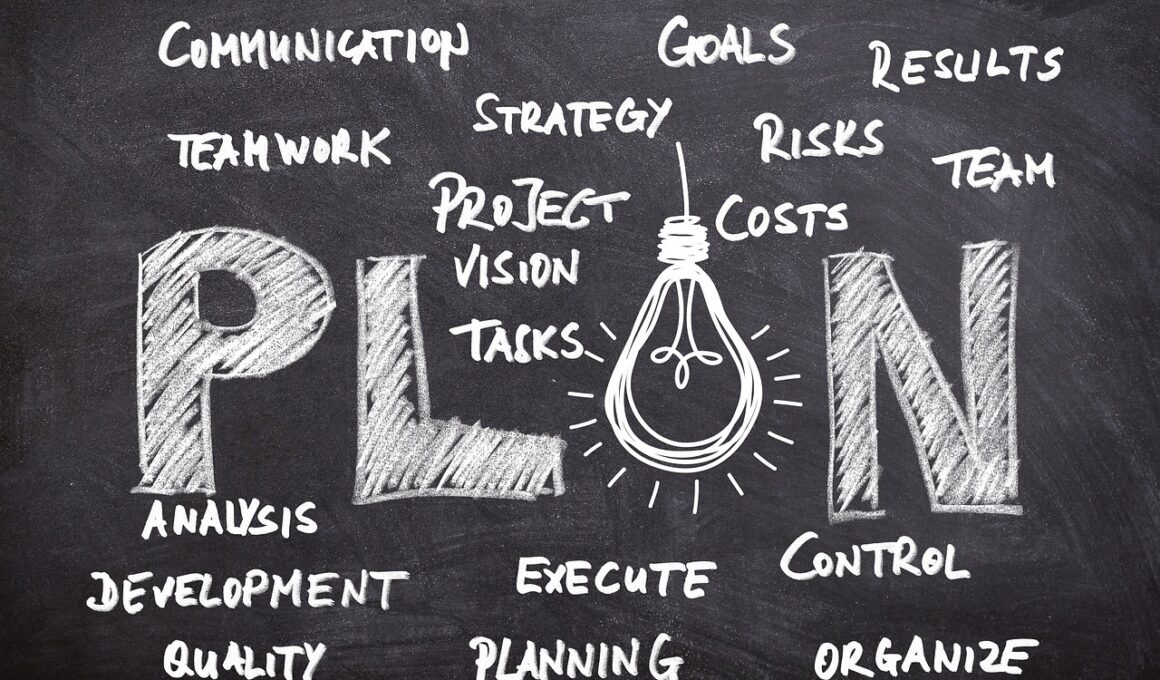Collaborative Approaches to Scenario Planning in Nonprofit Finance
Navigating the financial landscape of nonprofits today involves understanding potential future scenarios that can affect funding, resource allocation, and program sustainability. Scenario planning is a strategic method that allows organizations to prepare for uncertainties by envisioning various future conditions. Engaging stakeholders in this process enhances collective insights, bringing diverse perspectives into play. Nonprofits often operate under different funding models that can be influenced by economic variables, policy changes, and donor sentiments. The effectiveness of scenario planning relies on collaboration across various departments, ensuring comprehensive input from finance, program management, and community engagement teams. Utilizing collaborative tools such as workshops, brainstorming sessions, and structured interviews can foster an inclusive environment for sharing ideas. Additionally, leveraging technology like simulation software can help visualize potential outcomes and their implications on financial health. The key takeaway is that incorporating a diverse array of inputs can lead to robust and adaptable financial strategies that are responsive to emerging trends in the nonprofit sector. Thus, a collaborative approach ensures that the organization can not only survive but thrive amid uncertainty.
Successful scenario planning hinges on the participation of multiple stakeholders within the organization. By engaging staff from different levels, nonprofits can gather a broader spectrum of knowledge and insights, enriching the planning process. Financial teams can provide data-driven insights, while program managers can present on the potential impact of various scenarios on organizational initiatives. Board members also play a crucial role by contributing strategic direction and oversight. To facilitate collaboration, establishing a structured approach is vital. This could involve creating scenario planning teams dedicated to identifying challenges and opportunities. A common framework to guide discussions could also be beneficial. Regularly scheduled meetings and open forums will encourage continuous dialogue about financial health and projected impacts. Additionally, it’s important to embrace flexible frameworks that adapt as new information arises or situation changes. Collaboration should not be a one-time effort but rather an ongoing conversation. Building a culture of openness and cooperation instills a sense of ownership and responsibility, which can translate into better decision-making and strategic alignment towards shared goals. Collectively, this approach paves the way for resilient and sustainable financial management.
Identifying Key Drivers and Uncertainties
To effectively utilize scenario planning in nonprofit finance, it’s essential first to identify key drivers of change. These drivers might include shifts in donor behavior, government policy modifications, or economic downturns that affect funding prospects. Understanding these factors requires thorough research and analysis. Furthermore, analyzing uncertainties in the operating environment helps organizations prepare previously unconsidered risks. This involves evaluating various scenarios through a lens of potential change, which is essential for anticipating challenges and opportunities. Engaging stakeholders in brainstorming sessions can foster a comprehensive understanding of the external factors affecting the organization. Participants should rank these uncertainties in terms of likelihood and potential impact on the organization. Tools such as SWOT analysis can be employed here to structure discussions about strengths, weaknesses, opportunities, and threats. By collectively identifying these key drivers and uncertainties, nonprofits can create a more nuanced set of scenarios that accurately reflects the complexities of their operating environment. This collaboration also brings together diverse perspectives, leading to richer discussions and more comprehensive planning. Different viewpoints not only enhance creativity but also identify blind spots that might be missed by a single department.
Once key drivers and uncertainties are identified, it’s crucial to develop a range of scenarios that explore different futures for the organization. These scenarios should vary in terms of their feasibility and potential impact, enabling the organization to envision both favorable and unfavorable outcomes. It’s beneficial to categorize scenarios into optimistic, pessimistic, and moderate projections, which can guide strategic discussions. Engaging stakeholders in creating narratives for each scenario fosters ownership, making the eventual outcomes more relatable and understandable. Moreover, scenarios should not only reflect financial implications but should also consider operational impacts, including program delivery and community engagement. By constructing these narratives collaboratively, nonprofits ensure that they address a variety of concerns and create a shared vision of potential futures. Regular updates to these scenarios based on data and results help the organization remain agile and responsive. Technology can also aid in scenario visualization through dynamic modeling tools, making it easier for stakeholders to comprehend the implications of various decisions. In this way, scenario planning becomes a proactive strategy for navigating uncertainty, ensuring that nonprofits maintain their mission during times of change.
Strategic Decision Making Based on Scenarios
Utilizing scenarios effectively requires strategic decision-making processes informed by the insights gathered during planning sessions. Organizations should prioritize aligning their strategic goals with the scenarios developed, ensuring that their actions reflect the various possibilities outlined. This alignment empowers decision-makers to act promptly as circumstances evolve. It’s advisable to create a responsive action plan that details specific steps the organization will take under each scenario. For instance, responses may vary from increasing outreach efforts in a pessimistic scenario to expanding funding reserves in a more optimistic context. Regularly revisiting these plans during board meetings and staff discussions keeps everyone on the same page, encouraging dynamic adjustments. Documenting insights gained can also provide valuable context for future planning sessions, ensuring lessons learned inform ongoing strategy. Additionally, scenario outcomes can be integrated into the organizational learning culture, streamlining future planning efforts. Emphasizing adaptability within decisions allows nonprofits to pivot swiftly without losing sight of their core mission. Overall, scenario-driven decision-making is not just about being prepared; it aligns everyday actions with long-term strategic objectives, reinforcing organizational resilience against future uncertainties.
Engaging in continuous evaluation of the scenarios and their outcomes is essential for nonprofits to refine their strategies and adapt to changes. This evaluation should involve tracking key financial metrics, performance indicators, and stakeholder feedback throughout the implementation of strategies influenced by scenario planning. Establishing a feedback loop allows organizations to gauge whether their responses to various scenarios meet their expectations and adapt accordingly. Regular check-ins with staff and stakeholders can provide valuable insights into the efficacy of the actions taken. It’s beneficial to conduct reflection sessions where participants collectively analyze successes and challenges encountered in each scenario implementation. This encourages a culture of learning and improvement, enabling the organization to become more adept at navigating future uncertainties. Additionally, documenting the entire scenario planning process creates a knowledge base for new team members and can serve as a guide for similar endeavors. Over time, this practice builds greater institutional memory and a commitment to resilience. Thus, continuous evaluation and enhancement of scenario planning processes not only informs immediate decision-making but also strengthens the organization’s capacity to thrive in varying futures.
Building a Culture of Collaboration
Fostering a culture of collaboration is fundamental for successful scenario planning in nonprofit finance. This requires creating an environment where input from all levels of the organization is valued and respected. Leadership plays a crucial role in modeling collaboration by demonstrating openness to ideas and encouraging discussions across departments. Workshops and team-building activities can promote trust and encourage employees to contribute their insights freely. Additionally, highlighting the importance of shared knowledge supports a collective mindset toward addressing challenges. Recognizing and rewarding collaborative efforts can also motivate staff to remain engaged in this joint process. Incorporating storytelling methods to share successes and valuable lessons amplifies the appreciation of collaboration. Furthermore, utilizing collaborative technologies, such as shared platforms for planning documents or collaborative brainstorming tools, enhances communication among team members. A robust system for tracking contributions will also ensure everyone feels involved in shaping organizational futures. As nonprofit organizations navigate uncertainties, cultivating a collaborative culture strengthens resilience, empowering teams to tackle complex challenges collectively. This approach not only enriches scenario planning but reinforces the overall mission and effectiveness of the organization.
The significance of effective communication cannot be overstated in the context of collaborative scenario planning for nonprofit finance. Establishing clear channels for feedback and updates ensures that all participants are informed about developments and decisions made throughout the process. Regular communication fosters increasing transparency and enhances trust among stakeholders. Utilizing newsletters, meetings, and digital platforms facilitates the seamless flow of information. Moreover, creating visual representations of scenarios and strategies can help convey complex ideas to a broader audience. Engaging stakeholders through effective communication cultivates a sense of inclusion, making participants feel valued and encouraging their ongoing involvement in the scenario planning journey. Inviting feedback not only improves the planning process but can also uncover additional insights and perspectives. As scenarios evolve, consistent communication is essential to share lessons learned and adjustments made. This practice builds a shared understanding that reinforces collaboration and commitment. Ultimately, by prioritizing effective communication, nonprofits can navigate uncertainties with more confidence, adapting to challenges as they arise. Through informed decisions driven by strong collaboration and communication, organizations can fulfill their missions with greater agility and resilience.


